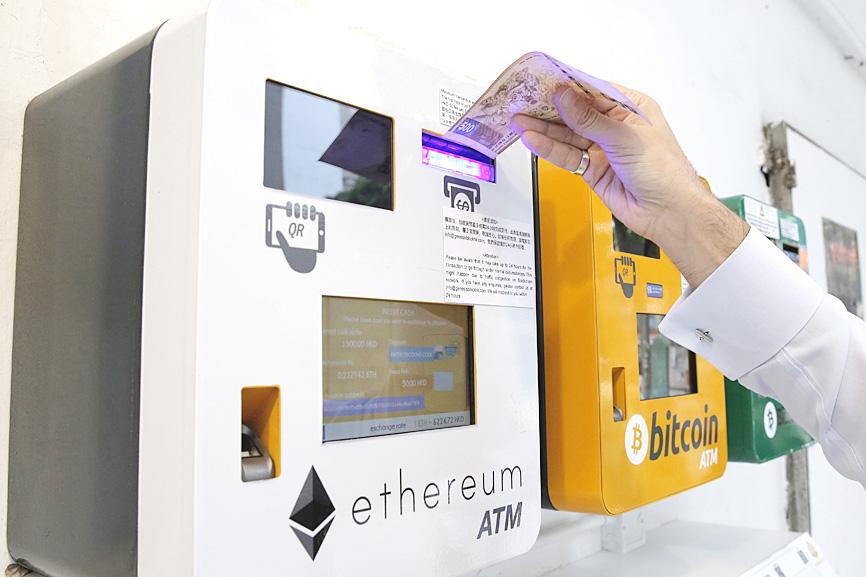With the speed cryptocurrency is emerging as the millennial generation’s alternative asset of choice in India, it is hard to imagine that just two years ago a couple of blockchain pioneers were briefly in police custody.
Sathvik Vishwanath and Harish BV, cofounders of a then five-year-old start-up, were arrested in late 2018. No, they had not pulled off a shady initial coin offering.
Their “crime” was that they put up a kiosk in a mall in Bangalore where customers could swap bitcoin, ether or ripple for cash or vice versa. That was the whole point of unocoin, their crypto token exchange. However, the police were suspicious of the new-fangled “ATM.”

Photo: AP
A lot has changed since then. Unocoin, which just raised financing from Tesla Inc backer Tim Draper’s Draper Associates, is flourishing, together with other Indian blockchain ventures.
India’s share of person-to-person virtual currency trading in Asia has surged to 33 percent, the same as in China, according to Oslo-based Arcane Research’s analysis of volumes on Paxful and LocalBitcoins, the biggest platforms for transactions in the region.
Some of this is no doubt due to the bubbly rise this year in bitcoin, which recently came within US$100 of its all-time high after surpassing US$19,000 for the first time since 2017. Even after Thursday’s wobble, prices have still more than doubled this year.
However, fundamental factors are also at play. Sending money to India in a tokenized form, and thus avoiding hefty bank charges, is becoming an option.
Some customers of digital-asset exchanges, probably tech-savvy freelancers, receive tokens at regular intervals as payment for their work and convert them into rupees via their local bank accounts. Families in India are using the same channel to send money to students overseas.
Having the world’s largest diaspora — and more than US$100 billion in two-way money flows last year — is not the only thing.
Indian Prime Minister Narendra Modi’s disastrous ban on 86 percent of the country’s currency in November 2016 shook Indians’ faith in fiat money. Add the fear of leaving spare cash in banks when three major deposit-taking institutions have crumbled in the past 15 months. No wonder Arcane expects Indian crypto volumes to overtake China’s.
The domestic asset management industry is also helping adoption of crypto — by its incompetence.
Most large-cap fund managers have struggled to beat their benchmarks, especially in the past few years. The NIFTY 50 has returned only about 2 percent annually in US dollar terms over the past decade. Yet, as Bloomberg Intelligence’s Gaurav Patankar and Morgan Barna have shown, lack of performance has not kept managers from pocketing high fees.
Disgruntled younger savers are taking note, and dipping their toes in US exchange-traded funds. At 1 percent, international allocation is still tiny, the Bloomberg Intelligence analysts said, but it is growing rapidly.
Ditto for crypto-investing, even though holding a highly volatile digital asset over the long term is not for the faint of heart.
Only 600 of unocoin’s 1.2 million customers have started a systematic buying plan to invest (mostly) in bitcoin, but 99.5 percent of them are sitting on profit, and must be bragging about it to their friends.
There is one dampener: regulation. Nobody wants a return to 2018, when the Reserve Bank of India, the monetary authority, instructed banks not to entertain customers who dealt in virtual currency.
The draconian approach nearly strangled India’s blockchain revolution.
The action against unocoin’s kiosk in Bangalore was like the heavy hand of the state crashing down on a kid’s lemonade stand. If folks in India’s technology capital could not pay cash to buy digital tokens, then the asset was effectively being banned nationwide.
In hindsight, the founders’ ordeal with the police proved to be a blessing in disguise. Young entrepreneurs joined together, went to the Indian Supreme Court in New Delhi and got the central bank’s direction to banks declared unconstitutional.
That was in March. Already, the exchange has seen a fivefold jump in trading, averaging US$150,000 a day, from US$30,000 before the court’s verdict.
Of late, trading is much higher, thanks to the rally in bitcoin prices. Larger bourses, such as CoinDCX, were witnessing daily volumes of almost US$700,000.
The players are urging the Indian government to bring digital assets under the existing money-laundering law, which would give the industry legitimacy. The next step would be to regulate the tokens as money or securities, depending on their use.
India’s phlegmatic bureaucracy might wonder if this is all a craze. Perhaps not. It is not even unique to Indian millennial and generation Z consumers. Wringing the global banking industry dry of its exorbitant fees, and putting more purchasing power in people’s hands after the COVID-19 pandemic, would be a worldwide goal.
In their study, titled “What We Must Do to Rebuild,” Deutsche Bank AG economists are advising companies and policymakers to design alternatives to credit cards and “remove middleman fees.”
In the short run, conventional financial technology would help, but in the longer term, major economies would all do this by replacing cash with their own central bank digital currencies.
That is when older consumers would join in. If they do not, they would get stuck, and not just figuratively. Automatically triggered crypto “smart contracts” would make it possible for self-driving vehicles to switch lanes faster than others. Commuters would be continuously paying one another in official digital currencies — or in stablecoins like Facebook Inc’s proposed libra, private tokens whose values are fixed against fiat money.
The Indian millennials have read the tea leaves right.
Andy Mukherjee is a Bloomberg Opinion columnist covering industrial companies and financial services. He previously was a columnist for Reuters Breakingviews. He has also worked for the Straits Times, ET NOW and Bloomberg News.
This column does not necessarily reflect the opinion of the editorial board or Bloomberg LP and its owners.

Taiwan’s exports soared 56 percent year-on-year to an all-time high of US$64.05 billion last month, propelled by surging global demand for artificial intelligence (AI), high-performance computing and cloud service infrastructure, the Ministry of Finance said yesterday. Department of Statistics Director-General Beatrice Tsai (蔡美娜) called the figure an unexpected upside surprise, citing a wave of technology orders from overseas customers alongside the usual year-end shopping season for technology products. Growth is likely to remain strong this month, she said, projecting a 40 percent to 45 percent expansion on an annual basis. The outperformance could prompt the Directorate-General of Budget, Accounting and

The demise of the coal industry left the US’ Appalachian region in tatters, with lost jobs, spoiled water and countless kilometers of abandoned underground mines. Now entrepreneurs are eyeing the rural region with ambitious visions to rebuild its economy by converting old mines into solar power systems and data centers that could help fuel the increasing power demands of the artificial intelligence (AI) boom. One such project is underway by a non-profit team calling itself Energy DELTA (Discovery, Education, Learning and Technology Accelerator) Lab, which is looking to develop energy sources on about 26,305 hectares of old coal land in

Netflix on Friday faced fierce criticism over its blockbuster deal to acquire Warner Bros Discovery. The streaming giant is already viewed as a pariah in some Hollywood circles, largely due to its reluctance to release content in theaters and its disruption of traditional industry practices. As Netflix emerged as the likely winning bidder for Warner Bros — the studio behind Casablanca, the Harry Potter movies and Friends — Hollywood’s elite launched an aggressive campaign against the acquisition. Titanic director James Cameron called the buyout a “disaster,” while a group of prominent producers are lobbying US Congress to oppose the deal,

Two Chinese chipmakers are attracting strong retail investor demand, buoyed by industry peer Moore Threads Technology Co’s (摩爾線程) stellar debut. The retail portion of MetaX Integrated Circuits (Shanghai) Co’s (上海沐曦) upcoming initial public offering (IPO) was 2,986 times oversubscribed on Friday, according to a filing. Meanwhile, Beijing Onmicro Electronics Co (北京昂瑞微), which makes radio frequency chips, was 2,899 times oversubscribed on Friday, its filing showed. The bids coincided with Moore Threads’ trading debut, which surged 425 percent on Friday after raising 8 billion yuan (US$1.13 billion) on bets that the company could emerge as a viable local competitor to Nvidia